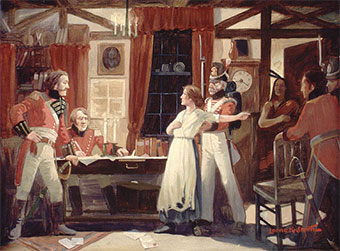Bloody Boys, Forty Thieves, and Lady Paul Revere
by Mason Winfield

It was late June, 1813. Driven out of Fort George, the British had pulled most of their strength out of Upper Canada. Based at today’s Niagara-on-the-Lake, the Americans settled into an occupation of the west side of the Niagara. They plundered farms, harassed locals, hardened attitudes against themselves, and endured misery of their own. The Empire’s irregular forces—Native allies and Canadian guerrillas—nipped at them so effectively that the Americans’ hard-won fort became a prison.
The Americans were safe in their perimeter around Fort George, but their supply lines were bedeviled, and every day was marked by clashes between “picket” (armed scout) parties in the heavy woods, in which the Empire’s allies excelled. One mid-June bushwhack that had to seem the living end took place in full sight of the fort. Some Mohawks attacked a supply boat in the Niagara, killing four soldiers and getting off scot-free into the woods that flanked the river.
A major stone in the Yankee shoe was a band of hit-and-run Robin Hoods led by Anglo-Irish Lieutenant James Fitzgibbon (1780-1863). Fifty men of the British 49th regiment (“the Green Tigers”) dressed in civilian clothing, rode all over the peninsula, signalled to each other with cowbells, and never slept two nights in the same place. They called themselves “the Bloody Boys,” and nipping their sanguine leader would be a major coup. When word came to Fort George that Fitzgibbon was staying at a house near Beaver Dams (now in Thorold, Ontario), American commander Brigadier General John Parker Boyd decided to try something.
Boyd sent recently promoted but little-respected 14th US Infantry Colonel Charles Boerstler and a 500-man strike force on the back route to sneak up on Fitzgibbon and come in shooting. The force included Buffalo’s Dr. Cyrenius Chapin and about 20 of his “Forty Thieves”—horse guerrillas, opposite numbers and bitter enemies of Fitzgibbon’s Bloody Boys. At sunset on June 23, the force left Fort George and quartered in Queenston village.
Something blew their plan. In Canadian tradition, some US officers discussed the scheme in the house of Canadian militia captain James Secord. Before daybreak on St. John’s Day, June 24, Secord’s wife Laura set out to warn Fitzgibbon. The US sentries let her pass, trusting that she was “just going to milk a cow.” Right. At 3am.
Mrs. Secord stumbled into the woods, ran northeast toward Beaver Dams, and found fate again playing favorites. She met a group of Native Americans and convinced them to take her to Fitzgibbon. They were probably Mohawk or their Christianized Canadian brethren called something like Kahnawake. (With up to 14 spellings, Kahnawake was the original name of the Mohawk, meaning “People of the Flint.” Mohawk—“cannibals”—was a name given them by others.) We’re not sure that without that fair white housewife the Mohawks would have missed a cannon-carting detachment in their own woods, but so goes the legend of Ontario’s lady Paul Revere.
The only force Fitzgibbon could rally—400 Native American allies, most Kahnawake—was perfect for forest-fighting. They and a token British detachment hid in thick woods east of Beaver Dams along the American route and served up a little home-cooking, a classic Iroquois bushwhack. Dr. Chapin and his Thieves sniffed it a mile off but couldn’t talk Boerstler out of blundering into it.
Wounded in the first exchanges and set in a wagon, Boerstler made one bad decision after another. The American force retreated into the open where they had the advantage and then surrendered. Stories vary, but most likely, Bloody Boy Fitzgibbon approached under a flag of truce, told Boerstler that he was surrounded by 1,000 British and Mohawk, and persuaded him that only an act of humanity—surrender—would prevent a massacre. The trick was already old in this war. (Raised on frontier folktales, many white Americans were totally spooked by Native ones, presuming them all kill-crazy. While exploiting it, the British got quite a kick out of the tendency.) Boerstler’s wound may have affected his will to fight, but he was clearly buffaloed by a lesser force.
While remembered as the hero of Beaver Dams, Fitzgibbon in his report gave all credit to the Mohawk, who may have suffered only 25 casualties. The US took triple the losses. Christian Mohawk commander John Norton was succinct: “The Kahnawake got the victory, the Mohawks got the plunder, and Fitzgibbon got the credit.”
The upshot of the Battle of Beaver Dams was twofold. For one, it drove morale at Fort George to a new low. If that many men could go out and not come back... How the trees around them must have seemed to teem daggers. And, till then, and precisely because of the stereotypes that scared it, the U. S. military had resisted using its own Native allies, not wanting to risk loosing them upon prisoners and civilians. Beaver Dams may have convinced it that it couldn’t win without them.
Mason Winfield is the author of 10 books, including Ghosts of 1812 (Western New York Wares, 2009), a history of the 1812 war on the Niagara.
blog comments powered by Disqus|
Issue Navigation> Issue Index > v12n25 (Week of Thursday, June 20) > Bloody Boys, Forty Thieves, and Lady Paul Revere This Week's Issue • Artvoice Daily • Artvoice TV • Events Calendar • Classifieds |









 Current Issue
Current Issue